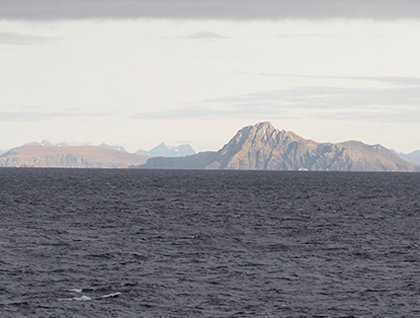Most of us slept through the 4:27 a.m. sunrise this morning, but by 6:30 a.m. many were out and about enjoying the vista of the islands of the Tierra del Fuego Archipelago. Our crossing of the Drake Passage had remained smooth throughout the night and the morning weather was clear, only lightly overcast and with a comfortable outside temperature of 6 degrees C, or 42 degrees F.
We could clearly see Cape Horn, which is actually an island, Islas Hornos, marking the transition from the Pacific Ocean in the west to the Southern Atlantic in the east. This locality is known not only for the numerous shipwrecks but for an abundance of natural features amongst the heavily dissected local landscape named for explorers and whalers, or their vessels. These include Cape Ross, Islas Freycinet, Islas Herschel, Canal Franklin, Cape Coquille, and Islas Chanticleer.
Although we had left Antarctica far astern there was no shortage of wildlife available for the naturalists amongst us. We spied rafts of black browed albatross on the water and wandering and northern royal albatross were also sighted on the wing. Giant petrels, white chinned petrels, sooty shearwaters, Cape petrels and imperial shags kept the birders busy while in the water peale’s and dusky dolphins, South American fur seals and Magellanic penguins could be seen.
The Beagle Channel was so named during a Royal Navy survey mission under the command of the expert Australian hydrographer, Captain Philip Parker King between 1826 and 1830. During the subsequent circumnavigation of the globe by the Beagle, the naturalist Charles Darwin wrote at length about the geography and natural science of the locality. Darwin’s extensive diary notes between mid-December 1832 and early February 1834 describes the lifestyle and economy of the indigenous Yaghans, also called Fuegians. On January 15th, 1833 described the channel thus:
“This channel, which was discovered by Captain Fitz Roy during the last voyage, is a most remarkable feature of this, or indeed of any other country: it may be compared the valley of the Lochness in Scotland, with its chain of lakes and friths*. It is about one hundred and twenty miles long, with an average breadth, not subject to any great variation, of about two miles: and is throughout so perfectly straight, that the view, bounded on each side by a line of mountains, gradually becomes indistinct in the long distance.”
Another important task for Captain Robert Fitzroy, master of the Beagle on the second voyage, was to return three native Fuegians to their land. York Minster, Jemmy Button, and Fuegia Basket were the survivors of a handful of natives that had been taken to England by the earlier expedition. Sadly, one other man had died of smallpox in England. Approaching the locality of Jemmy Button’s family and tribe Darwin wrote: “Fires were lighted at every point (hence the name of Tierra del Fuego, or the Land of Fire).”
Within the channel we chanced upon a group of sei whales, before picking up the Chilean pilot for the passage up the channel past Puerto Williams to Ushuaia.
* A ”Frith” is a long narrow inlet of the sea.







